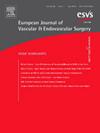症状性颈动脉近端闭塞患者经颅多普勒微栓塞信号的发生率
IF 5.7
1区 医学
Q1 PERIPHERAL VASCULAR DISEASE
European Journal of Vascular and Endovascular Surgery
Pub Date : 2025-04-01
DOI:10.1016/j.ejvs.2024.11.012
引用次数: 0
摘要
目的:症状性颈动脉近端闭塞患者的缺血性中风是由栓塞机制还是血流动力学机制引起的,目前尚不清楚。栓塞机制可通过经颅多普勒出现微栓塞信号(MES)来反映。本研究旨在比较无症状近闭塞、无症状常规≥50%狭窄和无症状≥50%狭窄患者的微栓塞信号发生率:这项横断面研究包括有症状或无症状≥50%颈动脉狭窄的患者。通过计算机断层扫描血管造影评估狭窄程度,并通过特征判读诊断近闭塞。六个月内发生同侧事件即为症状。使用经颅多普勒记录双侧大脑中动脉 30 分钟内 MES 的发生情况:结果:共纳入了109名颈动脉狭窄≥50%的参与者,其中52人有症状≥50%的常规狭窄,41人有症状接近闭塞,16人无症状≥50%的狭窄。在有症状的近闭塞中,MES的发生率为46%(19/41;95%置信区间[CI] 30 - 62%);在有症状的≥50%常规狭窄中,MES的发生率为27%(14/52;95% CI 14 - 39%);在无症状的≥50%颈动脉狭窄中,MES的发生率为6%(1/16;95% CI 0 - 20%)。与无症状的≥50%常规狭窄相比,有症状的近闭塞患者的MES发病率往往更高(未调整的比值比[OR] 2.3,95% CI 1.0 - 5.6;p = .054),但经调整后,MES的发病率在统计学上明显更高(调整后的比值比[OR] 3.9,95% CI 1.4 - 10.7;p = .009)。有症状的近闭塞患者的微栓塞发生率高于无症状的≥50%狭窄患者(P = .005):结论:与有症状的常规≥50%颈动脉狭窄和无症状的常规≥50%颈动脉狭窄相比,微栓塞信号在有症状的近闭塞中似乎更普遍。这些发现可能反映了无症状颈动脉近闭塞缺血性卒中背后可能存在的栓塞机制,但不能排除同时存在的血流动力学机制。有必要使用栓塞和血流动力学机制的各种标记物进行更多研究。本文章由计算机程序翻译,如有差异,请以英文原文为准。
Incidence of Microembolic Signals on Transcranial Doppler among Patients with Symptomatic Carotid Near Occlusion
Objective
It is unclear whether ischaemic stroke among patients with symptomatic carotid near occlusion is caused by an embolic or haemodynamic mechanism. An embolic mechanism can be reflected by the occurrence of microembolic signals (MES) on transcranial Doppler. This study aimed to compare the incidence of MES between patients with symptomatic near occlusion, symptomatic conventional ≥ 50% stenosis, and asymptomatic ≥ 50% stenosis.
Methods
This cross sectional study included patients with ≥ 50% symptomatic or asymptomatic carotid stenosis. The degree of stenosis was assessed with computed tomography angiography, where near occlusion was diagnosed by feature interpretation. Symptomatic was defined as ipsilateral events within six months. Occurrence of MES was recorded bilaterally in the middle cerebral artery for 30 minutes with transcranial Doppler.
Results
A total of 109 participants with ≥ 50% carotid stenosis were included, comprising 52 with symptomatic ≥ 50% conventional stenosis, 41 symptomatic near occlusion, and 16 asymptomatic ≥ 50% stenosis. The incidence of MES was 46% (19/41; 95% confidence interval [CI] 30 – 62%) among symptomatic near occlusion, 27% (14/52; 95% CI 14 – 39%) among symptomatic ≥ 50% conventional stenosis, and 6% (1/16; 95% CI 0 – 20%) among asymptomatic ≥ 50% carotid stenosis. The incidence of MES tended to be higher among symptomatic near occlusions compared with symptomatic ≥ 50% conventional stenoses (unadjusted odds ratio [OR] 2.3, 95% CI 1.0 – 5.6; p = .054), but was statistically significantly higher after adjustments (adjusted OR 3.9, 95% CI 1.4 – 10.7; p = .009). The MES incidence was higher among symptomatic near occlusions than asymptomatic ≥ 50% stenoses (p = .005).
Conclusion
Microembolic signals appear to be more prevalent in symptomatic near occlusions compared with both symptomatic conventional ≥ 50% carotid stenoses and asymptomatic conventional ≥ 50% carotid stenoses. These findings could reflect a possible embolic mechanism behind ischaemic stroke in symptomatic carotid near occlusion patients, but do not rule out concurrent haemodynamic mechanisms. Additional studies using various markers of both embolic and haemodynamic mechanisms are warranted.
求助全文
通过发布文献求助,成功后即可免费获取论文全文。
去求助
来源期刊
CiteScore
6.80
自引率
15.80%
发文量
471
审稿时长
66 days
期刊介绍:
The European Journal of Vascular and Endovascular Surgery is aimed primarily at vascular surgeons dealing with patients with arterial, venous and lymphatic diseases. Contributions are included on the diagnosis, investigation and management of these vascular disorders. Papers that consider the technical aspects of vascular surgery are encouraged, and the journal includes invited state-of-the-art articles.
Reflecting the increasing importance of endovascular techniques in the management of vascular diseases and the value of closer collaboration between the vascular surgeon and the vascular radiologist, the journal has now extended its scope to encompass the growing number of contributions from this exciting field. Articles describing endovascular method and their critical evaluation are included, as well as reports on the emerging technology associated with this field.

 求助内容:
求助内容: 应助结果提醒方式:
应助结果提醒方式:


